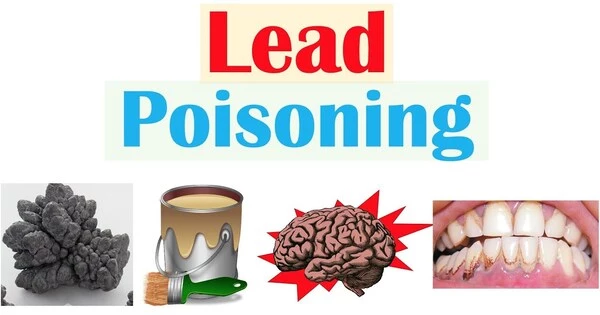Lead poisoning is a type of metal poisoning caused by lead in the body. It is also known as plumbism and saturnism. The most sensitive organ is the brain. It can affect people of all ages, but it is especially dangerous to infants, young children, and developing foetuses. Abdominal pain, constipation, headaches, irritability, memory problems, infertility, and tingling in the hands and feet are some of the symptoms. Children are more vulnerable to lead exposure because their bodies absorb lead more readily as they grow, and their brains and nervous systems are still developing. It accounts for nearly 10% of intellectual disability from previously unknown causes and can lead to behavioural issues. Some of the effects are long-term. Anaemia, seizures, coma, or death may occur in severe cases.
Lead exposure can occur through contaminated air, water, dust, food, or consumer products. Children are at a significantly higher risk of lead poisoning because they are far more likely to ingest lead indirectly through chewing on lead-coated toys or other objects. The amount of lead that children can absorb is also greater than that of adults. Workplace exposure is a common cause of lead poisoning in adults, with certain occupations being particularly vulnerable.
The blood lead level is typically used to make a diagnosis. The Centres for Disease Control and Prevention (CDC) has set the upper limit for blood lead for adults at 10 µg/dl (10 µg/100 g) and for children at 3.5 µg/dl, up from 5 µg/dl prior to October 2021. Elevated lead levels can also be detected by changes in red blood cells or dense lines in children’s bones as seen on X-ray.
Exposure to lead can occur through multiple routes, including:
- Ingestion: Children may ingest lead by hand-to-mouth contact with lead-contaminated dust, soil, or objects. Lead-based paint in older homes is a common source of ingestion.
- Inhalation: Breathing in lead dust or fumes, particularly in workplaces where lead is used or inhaled during hobbies like painting or soldering, can lead to lead poisoning.
- Water: Lead can leach into drinking water from old plumbing pipes or fixtures made of lead or with lead solder.
- Consumer products: Certain imported items, such as toys, cosmetics, and pottery, may contain lead-based paint or have lead content above acceptable levels.
Lead poisoning symptoms can vary depending on the level and duration of exposure. Developmental delays, learning difficulties, irritability, loss of appetite, weight loss, fatigue, abdominal pain, vomiting, and hearing loss are all possible symptoms in children. Adults may experience symptoms such as high blood pressure, joint and muscle pain, memory loss, mood disorders, reproductive problems, and digestive problems.
If you suspect lead poisoning, seek medical attention right away. A blood test can be used to determine the amount of lead in the body. The treatment consists of removing the source of lead exposure, providing supportive care, and, in severe cases, using chelation therapy to remove lead from the body.
Preventing lead poisoning is crucial, especially in children. Measures to reduce exposure include:
- Ensuring a safe living environment: Regularly inspecting and addressing any lead hazards in homes, especially in older houses with lead-based paint.
- Proper hygiene: Frequent handwashing, particularly before meals, and cleaning floors and other surfaces to minimize dust.
- Nutrition: Providing a balanced diet with sufficient iron, calcium, and vitamin C can help reduce the absorption of lead.
- Drinking water: Flushing taps before use and using cold, filtered water for drinking and cooking can minimize lead exposure.
- Lead-safe practices: Following safety guidelines when working with or renovating older homes that may contain lead-based paint.
















